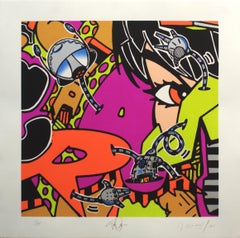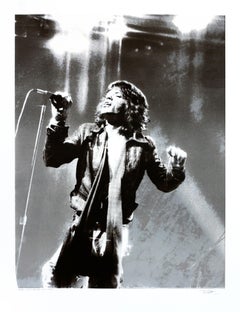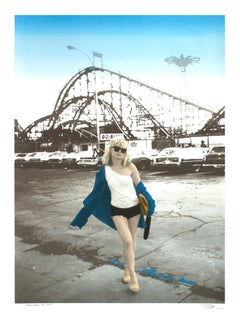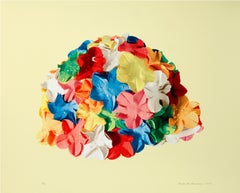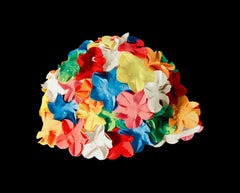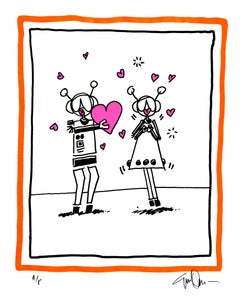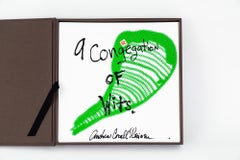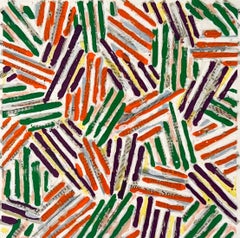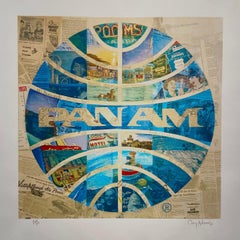Berkshires - Figurative Prints
to
1
2
2
2
Overall Width
to
Overall Height
to
4
3
2
2
1
3
4
2
1
4
2
1
2
2
2
2
2
1
1
1
1
1
1
1
1
1
1
1
7
18,499
17,331
Item Ships From: Berkshires
Pleased to Meet You Again
Located in North Adams, MA
Silkscreen in 9 colors on 320 gram Coventry Rag
Dimensions: 29" x 29"
Signed by the Artists in pencil
An edition of 75
John “CRASH” Matos and Eric Orr met for the first time as high school students. Although the exact location is unclear, both agree that it would have been at either Fashion Moda or the Writers’ Bench at 149th Street and Grand Concourse.
Founded by Stefan Eins in 1978, Fashion Moda began as a “cultural concept” whose principles revolved around the fact that art can be made by anyone, anywhere and art should be accessible to anyone, anywhere. Located in the South Bronx, Fashion Moda embraced new talent and encouraged creative production across all mediums. The gallery has been credited as a major force behind the recognition of graffiti writing as an art form and it played a pivotal role in a community where Hip Hop was rapidly emerging. CRASH was only 19 years old when he curated “Graffiti Art Success for America” at Fashion Moda and his varied experiences at the gallery would later inspire his founding of WALLWORKS.
The 149th Street Writers’ Bench, located at the back of the uptown...
Category
21st Century and Contemporary Street Art Berkshires - Figurative Prints
Materials
Screen
Mick Jagger-NYC - 1972
By Bob Gruen
Located in North Adams, MA
Silkscreen in 7 colors with diamond dust
40 x 54 inches
2-Ply Museum Board
Edition of 50
2014
Bob Gruen is one of the most well-known and respected photographers in rock and roll. F...
Category
1970s Contemporary Berkshires - Figurative Prints
Materials
Screen
Debbie Harry - NYC - 1977
By Bob Gruen
Located in North Adams, MA
Silkscreen in 10 colors
40 x 54 inches
2-Ply Museum Board
Edition of 50
2014
Bob Gruen is one of the most well-known and respected photographers in rock and roll. From John Lennon t...
Category
1970s Contemporary Berkshires - Figurative Prints
Materials
Screen
Multicolor Bathing Cap
By Carole Feuerman
Located in North Adams, MA
Silkscreen on 2-Ply Museum Board
38 x 30 inches
Edition of 20
2014
Carole Feuerman is one of the world’s foremost hyperrealist sculptors. Her resin, bronze and marble sculptures of swimmers and bathers evoke notions of tranquility and serenity.
Feuerman’s life-like works are nearly indistinguishable from the subjects that inspire them.
Her newest silkscreen edition is a testament to the same sense of realism. Soft and subtle blends of color support the tactile qualities of her bathing caps...
Category
21st Century and Contemporary Contemporary Berkshires - Figurative Prints
Materials
Screen
Multicolor Bathing Cap
By Carole Feuerman
Located in North Adams, MA
Silkscreen on 2-Ply Museum Board
38 x 30 inches
Edition of 10
2014
Carole Feuerman is one of the world’s foremost hyperrealist sculptors. Her resin, bronze and marble sculptures of swimmers and bathers evoke notions of tranquility and serenity.
Feuerman’s life-like works are nearly indistinguishable from the subjects that inspire them.
Her newest silkscreen edition is a testament to the same sense of realism. Soft and subtle blends of color support the tactile qualities of her bathing caps...
Category
21st Century and Contemporary Contemporary Berkshires - Figurative Prints
Materials
Screen
Falling For You
By Eric Orr
Located in North Adams, MA
"Falling for You," Eric Orr, 2022
Silkscreen on 290 gram Coventry Rag paper
Dimensions: 13 3/4" x 17 1/4"
Signed and numbered by the Artist in pencil
An editio...
Category
2010s Street Art Berkshires - Figurative Prints
Materials
Screen
Repeat
Located in North Adams, MA
In 1984, Eric Orr and Keith Haring joined forces to create a series of chalk drawings in the NYC subways. As their work evolved, the artists shifted their focus from the subway to the studio and embarked on the production of a suite of drawings. Included in the group was Repeat which had made its first appearance in the 23rd Street IRT uptown station. Little did Orr and Haring know that the reimagined drawing would be auctioned at Christie’s six years later. 2020 heralds a new beginning for Repeat, a truly unique silkscreen print that both illustrates and celebrates a fierce friendship that began in the early 1980s at The Roxy roller rink in NYC, when two young artists decided to trade t-shirts on the dance floor.
Repeat, Eric Orr and Keith Haring, 2020
Silkscreen on 320 gram Coventry Rag paper with hand-deckled edges
Dimensions: 20 x 28 inches
Edition Size: 250 with 25 Artist Proofs and 25 Printer Proofs
Signed and numbered in pencil by Eric Orr
Plate signed by Eric Orr and Keith Haring
Courtesy of Eric Orr and the Keith Haring Foundation
Printed and Published by Gary Lichtenstein...
Category
1980s Street Art Berkshires - Figurative Prints
Materials
Screen
Related Items
"CONGREGATION OF WITS: BOX SET", 41 silkscreen prints, double-sided, custom box
By Andrew Cornell Robinson
Located in Toronto, Ontario
"CONGREGATION OF WITS, Box Set of 41 Prints", 2018, limited-edition collection of 40 double-sided silkscreen prints, plus one title print, by Andrew Cornell Robinson. There are 10 box sets in custom-made chocolate linen archival boxes with a gold stamped title. Each print is signed, stamped and editioned. The prints measure 17x17", the box 17.5x17.5".
Note the double-sided printing – surfaces of text, surfaces of image. The installation (see photos above) is a striking performance in itself with myriad possibilities for color, pattern, language, culture, politics, identity. The artist is pleased to offer guidance on the installation, according to the collector's wishes. Or a collector may arrange personally. It's a dynamic body of work that delights in the craft of making and the experience of revealing a tapestry of image and language.
Initially inspired by a visit to the Talking Sculptures...
Category
21st Century and Contemporary Contemporary Berkshires - Figurative Prints
Materials
Paper, Archival Paper, Color, Screen, Linen
Jasper Johns Untitled
By Jasper Johns
Located in Washington, DC
Artist: Jasper Johns
Title: Untitled
Medium: Screenprint in colors on Patapar printing parchment
Year: 1977
Edition: 3000
Frame Size: 18 1/2" x 18 1/2"
Sheet Size: 10 5/8" x 10 1/4"
...
Category
1970s Pop Art Berkshires - Figurative Prints
Materials
Screen
Love is in the Air (Toronto)
By Mr. Brainwash
Located in Washington, DC
Artist: Mr. Brainwash
Title: Love is in the Air (Toronto)
Medium: Screenprint in colors on wove paper
Date: 2019
Edition: PP 2/5 (aside from the edition of 50)
Sheet Size: 30" x 22 1...
Category
2010s Contemporary Berkshires - Figurative Prints
Materials
Paper, Screen
BASQUIAT : DOWNTOWN 81" Réalisé par Edo BERTOGLIO en 2000 signed by Maripol
By (after) Jean-Michel Basquiat
Located in Pasadena, CA
JEAN-MICHEL BASQUIAT : DOWNTOWN 81" Réalisé par Edo BERTOGLIO en 2000 avec Jean-Michel BASQUIAT / Affiche originale entoilée / FKGB ARGUMENTS (2000) signed by Maripol directrice arti...
Category
Late 20th Century Street Art Berkshires - Figurative Prints
Materials
C Print
$1,500
H 26 in W 33 in D 2 in
Shepard Fairey Signed Print 2013 God Saves & Satan Invests Street Art Guns Urban
By Shepard Fairey
Located in Draper, UT
A portion of the proceeds from this print will go to a, yet to be determined, common sense gun law advocacy group. We need to put pressure on the politicians!
-Shepard Fairey
This GOD SAVES & SATAN INVESTS print was inspired by the multiple school and mass shootings that have occurred in recent months. As many of you know from my 2nd Amendment...
Category
2010s Street Art Berkshires - Figurative Prints
Materials
Screen
Double Decoy, Pop Art screenprint by Hunt Slonem
By Hunt Slonem
Located in Long Island City, NY
Double Decoy
Hunt Slonem, American (1951)
Date: 1980
Screenprint, signed and numbered in pencil
Edition AP 30
Image Size: 22 x 26.5 inches
Size: 26 in. x 30.5 in. (66.04 cm x 77.47 c...
Category
1980s Contemporary Berkshires - Figurative Prints
Materials
Screen
NYCHOS - Dissection of Homer Simpson Screen Print Art Urban Street The Simpsons
Located in Draper, UT
Step into the vibrant world of urban artistry with NYCHOS' "Dissection of Homer Simpson" screen print, a captivating piece that melds street sensibilitie...
Category
2010s Street Art Berkshires - Figurative Prints
Materials
Screen
$1,798
H 29.53 in W 24 in
Keep a Child Alive (Pink)
By Mr. Brainwash
Located in Washington, DC
Artist: Mr. Brainwash
Title: Keep a Child Alive (Pink)
Medium: Screenprint in colors on archival paper
Date: 2012
Edition: HC (aside from the edition of 150)
Sheet Size: 30" x 22 1/4...
Category
2010s Contemporary Berkshires - Figurative Prints
Materials
Paper, Screen
"Kate Moss. Boyfriends Underpants" Photography 50x40 in Ed. of 20 by Kate Garner
By Kate Garner
Located in Culver City, CA
"Kate Moss. Boyfriends Underpants" Photography 50x40 in Ed. of 20 by Kate Garner
Hahnemuhle fine art archival paper
Not framed. Ships rolled in tube.
Kate Garner: Seeker, Sage, and Preservationist of Identity
A thoughtful selection of Kate Garner’s most pivotal work, showing the arc of identity, and her expression as one of the great masters of fine art photography today. In this collection of works, see rare and seldom viewed images of Kate Moss, Angelina Jolie, David Bowie, FKA Twigs, and more.
Kate Garner evolved in the edgy pop-punk heyday of 1980’s London. By the time she was in her early 20s, she was well on her way to becoming one of the most enigmatic fine art photographers of our time. But it didn’t start that way. Until Kate was 19, she had spent most of her time in a tough mining town in the north of England. It was a practical place with practical people that studied practical vocations and couldn't afford to let themselves dream too much.
Growing up, Kate had expected a similar existence, but it was never what she had envisioned. Like much of her class, she attended formal trade education at the local vocational college after graduating secondary school and spending a year hitch-hiking from England, through Europe, Afghanistan, Iran, Pakistan to India Garner came back from India and started to study commercial photography, and in Northern England, that meant--pots and pans. But, Kate knew she was different and would often take herself down into the thriving metropolis of London to see and experience the vibrant Mecca of arts and creatives.
Her creative path took a pivotal point when her wanderings introduced her to the Blitz Kids. The art students and teenage squatters took her in, and It wasn’t long before she began shooting the streets with London’s party scene artisans and gender-bending pioneers. Working with John Galliano, Stephen Jones, Boy George, and later even David Bowie--Kate became fully immersed in the New Romantic...
Category
20th Century Contemporary Berkshires - Figurative Prints
Materials
Archival Ink, Archival Paper
$7,000
H 50 in W 40 in D 0.1 in
"Milla pink blue Uke" Photography 29" × 20" in Edition 2/20 by Kate Garner
By Kate Garner
Located in Culver City, CA
"Milla pink blue Uke" Photography 29" × 20" in Edition 2/20 by Kate Garner
Hahnemuhle fine art archival paper
Kate Garner: Seeker, Sage, and Preservationist of Identity
Not framed...
Category
21st Century and Contemporary Contemporary Berkshires - Figurative Prints
Materials
Archival Paper, Archival Ink
$2,000
H 29 in W 20 in D 0.1 in
NO REPLY PORTFOLIO
By KAWS
Located in Aventura, FL
No Reply Portfolio by KAWS. Screenprint on wove paper. Each of the 10 screen prints are hand signed, dated and numbered by the artist. Edition PP 3/5. (Pr...
Category
21st Century and Contemporary Street Art Berkshires - Figurative Prints
Materials
Paper, Screen
Mr Doodle - Yellow Flower - Street Art
By Mr Doodle
Located in London, GB
Mr Doodle
Yellow Flower, 2019
Screenprint on paper
Signed, dated and numbered
Edition of 100
34 by 34 cm. 13⅜ by 13⅜ in
framed
Mr Doodle, born Sam Cox in 1994 in England, is a cont...
Category
2010s Street Art Berkshires - Figurative Prints
Materials
Screen
Previously Available Items
PAN AM
By Cey Adams
Located in North Adams, MA
"PAN AM", Cey Adams 2021
Silkscreen and mixed media on 320 gram Coventry Rag paper
Dimensions: 30" x 30"
Signed, Titled and Numbered by the Artist in pencil
Edition of 40
PAN AM has a storied history in Cey’s studio, first created as a painting within his Trusted Brands collection and then reimagined as a suite of hand-collaged monoprints in different color variations at Gary Lichtenstein Editions...
Category
21st Century and Contemporary Contemporary Berkshires - Figurative Prints
Materials
Mixed Media, Screen
PAN AM
By Cey Adams
Located in North Adams, MA
"PAN AM", Cey Adams 2021
Silkscreen and mixed media on 320 gram Coventry Rag paper
Dimensions: 30" x 30"
Signed, Titled and Numbered by the Artist in pencil
Edition of 40
PAN AM has a storied history in Cey’s studio, first created as a painting within his Trusted Brands collection and then reimagined as a suite of hand-collaged monoprints in different color variations at Gary Lichtenstein...
Category
2010s Street Art Berkshires - Figurative Prints
Materials
Mixed Media, Screen
John Lennon, Statue of Liberty, New York City
By Bob Gruen
Located in North Adams, MA
Silkscreen and mixed media
290 gram Coventry Rag paper
Dimensions: 17” x 23”
Signed, Titled and Numbered by the Artist in pencil
An edition of 200
Bob Gruen met John Lennon in 1971,...
Category
1970s Contemporary Berkshires - Figurative Prints
Materials
Screen
Recently Viewed
View AllMore Ways To Browse
Fernando Andriacci On Sale
Fiore De Henriquez
Francisco Goya The Prisoner
Francisco Rodon
Fred Larson
Gary Benfield
Gay Vintage Jockstrap
Guilty Mickey Mouse
H Otsuka
Hall Diteman
Haring Great Peace March 1986
Harold Cleworth
Heinrich Hirt
Henry Gerbault
Henry Moore Sheep
Heran Chaban
Herbert L. Fink On Sale
Hogarth Election
